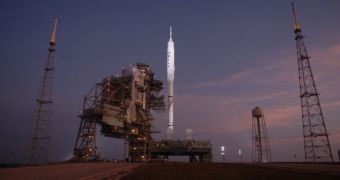Originally, the launch date for NASA's new prototype rocket was set for yesterday, October 27. Everything went according to plan, and the craft was rolled out to Launch Pad 39B at the Kennedy Space Center (KSC) with time to spare. An 8 am EDT (1200 GMT) launch time was targeted, but the built-in safety delay was extended for a couple of hours more, and then the flight was recycled altogether. The main reasons for this were the clouds that loomed over the pad.
According to the weather officer at the KSC, the clouds risked inflicting the tribo electrification phenomenon on the suborbital test rocket, so all activities were halted. Pad winds were also above the maximum allowed threshold, blowing at more than 23 knots below the test rocket. The top acceptable limit was of 20 knots. “We had some opportunities, we just didn't get there – the weather didn't cooperate,” Ed Mango, the ARES I-X launch director, said of the failed launch attempt yesterday afternoon.
Today's launch window also extends for four hours, but mission managers are targeting an 8 am EDT (1200 GMT) lift-off. The weather forecast for today is also looking slightly better than that for yesterday. Weather officials announce that a 40-percent chance of showers exists for today, a significant reduction from yesterday's 60 percent. This means that there is also a chance pad winds will be reduced. These air flows are very dangerous because they can trigger excessive, unwanted vibrations in the rocket, which can lead to its destruction.
There are more than 700 sensors aboard the suborbital test spacecraft at this point, which is made up of two stages. The first one features four live segments and a bogus one, while the second features only dummy payloads that simulate the Orion Crew Exploration Vehicle and other instruments. The stated goal of this flight is to test stage separation, and also to go through ground-based operations and associated managing processes. For more details of the launch, keep an eye on this space.

 14 DAY TRIAL //
14 DAY TRIAL //